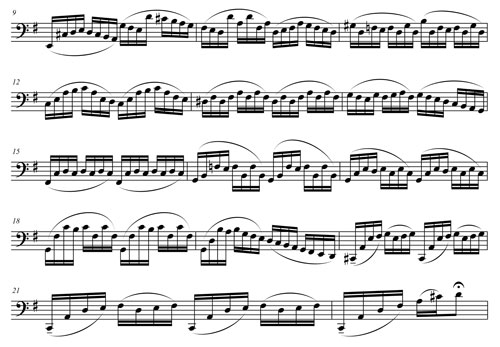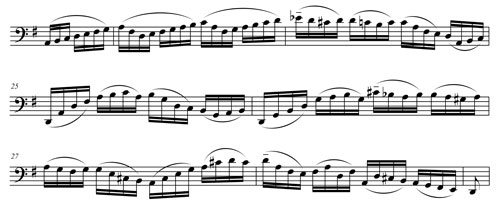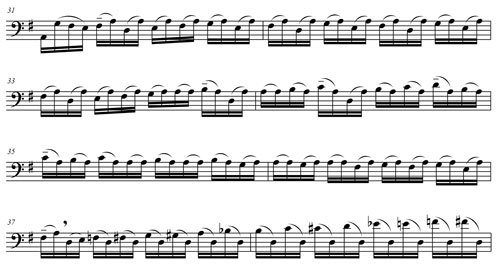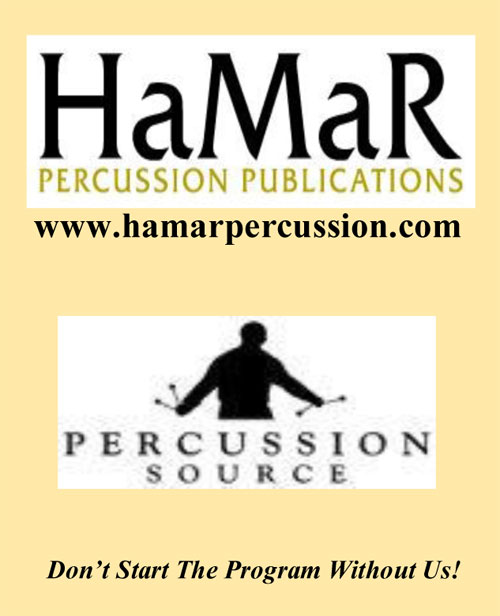Thank goodness for transcriptions. Many musicians want to play masterpieces written for other instruments on their instrument, and there are many pieces in the repertoire that work well as transcriptions. Of all the pieces frequently transcribed for other instruments, the Prelude to Bach’s first cello suite understandably is one of the most popular. It is an excellent composition, it was written for an unaccompanied monophonic instrument, and its texture of gently rolling chords is compelling.
Over the years, I have heard this piece performed on many different instruments. My colleagues will often send students who are working on this piece to me so that they can get feedback from a cello professor. I wanted to share the suggestions and advice – some minor and some quite significant – that I often find myself giving. Let us start with some general priorities that apply to the entire movement.
Smoothness
Bach wrote several pieces, most of them preludes, that are based on rolling or unfolding chords in a particular manner. The more you can make them sound like rolled chords rather than individual, disconnected notes, the better. Try to make each note resonate so much and so well that its vibrations spill over a little bit into the beginning of the next note. Also, take care with all of the large leaps in this piece, ensuring that they do not result in a note that gets accented or that accidentally pops out from the texture.
Cleanliness
A relative of smoothness, cleanliness means that each note gets articulated well and clearly, while devices such as portamento and portato be avoided.
Intonation
Intonation is especially critical in a piece like this, in which any deviations from pure intonation are noticeable and limit the effectiveness of the performance. In this style, it is best to tune pitches with the key in mind rather than with equal temperament.
Harmony and Voice Leading
I believe that performers always benefit from understanding the harmonic progression, key relationships, and voice leading that occur in any piece. This is especially true in instrumental preludes and works by Bach. Sometimes the best and simplest way to figure these things out is at a keyboard: play each measure as a blocked chord on the piano, leaving out the non-chord tones, and note the way that Bach moves the various voices from one chord to the next. An exercise like this makes apparent which measures to lean on and which ones to relax during. If you can also bring out the large-scale voice leading motions, your performance will immediately sound more mature and convincing.
Rhythm
As with several other Baroque preludes, this one consists almost entirely of one note value (in this case, sixteenth notes). It is easy to play them too evenly, in which case they can sound robotic. However, taking agogic liberties too often can entirely destroy the intention of the piece.
Phrasing and Breathing
Even if you perform this piece on an instrument that does not require breath, phrasing is still important. You need not phrase as often as a wind player would, but you should bring out the four-bar groupings that pervade the piece.
If you play a wind instrument, you have the opposite problem: you need to hide most of your breaths as much as possible. Tempo can help considerably. The faster you play the piece, the fewer breaths you have to take, and there is less concern about breaths getting in the way of the longer line. Of course, there is such a thing as too fast, but if you have good technique and follow the advice above, then a brighter alla breve tempo should sound flowing rather than frantic.
Choosing whether to breathe just before or after a downbeat is a problem, because the notes just before the downbeat do sound like pickups, but the downbeat itself sounds like the generator of the rest of the measure. You may be able to minimize the problem by avoiding it is much as possible, taking every opportunity to phrase somewhere within the measure. However, if you must breathe near a downbeat, I favor just before the downbeat if it contains a rolled chord and just after it if it does not.
Below are more suggestions that are specific to particular passages:
Measure 1
You can benefit from investing substantial practice time on this one measure, as it sets the tone for the next 22 measures, and in many ways for the piece as a whole.
• The second half of the measure repeats the material in the first half. It is acceptable to play these two half bars the same sometimes, but at least some of the time you will want to vary the second half of the bar, so these repetitions do not sound predictable and pedantic. Experiment in this first measure with different ways to play the second half differently from the first. The most common variation is to play the second half of the measure as an echo – slightly softer than the first half. However, in some measures you may also try playing the second half of the bar louder, with a slight hairpin, or with a slight crescendo or decrescendo into the following measure.
• Notes three through five contain a neighbor figure, which is the seed of upcoming scale-wise melodic material. Consider playing these three notes slightly differently from the other notes in the figure, such as by bringing them out a tiny bit.
Measures 1-4

The primary purpose of a prelude in a Baroque suite is to establish the key for the movements that follow, and Bach in particular often assigns this role strongly to the chord progression of the first four measures, as in this Prelude.
• Increase the energy as the dissonance increases, maximizing in the third measure and relaxing in the fourth.
• The most surprising note in the first four measures is the last one. This F# sets up a passing motion from the G two notes before it to the E that comes two notes after. As it is a surprise, and because it also helps to foreshadow the stepwise melodies that are about to begin, do not play it as if it were just another sixteenth note. A slight tenuto on this note can be very effective.
Measures 5-8

This passage begins to move the piece away from G major and also begins a pattern of alternation between melodic (i.e., more conjunct) and harmonic (i.e., rolled chords) measures.
• Find a convincing way to draw the listener’s attention to the alternation between these two types of material. For example, you could bring out the melodic measures slightly, or you could play the melodic material in a way that emphasizes the groupings of the various motives. (For example, measure five could be played as a group of 5 + 4 + 4 + 3 notes.)
Measures 9-22

In this passage, Bach continues to alternate between melodic and harmonic measures, but not always in the same pattern as in mm. 5-8. Bach takes us briefly through some different key areas (E minor, D major, and A minor) before returning to G major, ending on the dominant chord.
• Carefully tune the chromatic pitches (i.e., mm. 9, 11, and 13) to bring out the key changes.
• Measures 9 and 10 are arguably the first climax of the piece, as they consist of the largest ambitus (nearly two octaves) thus far, and they contain the only instance in the first half (mm. 1-22) of two consecutive melodic measures. Bring out these two measures, primarily through dynamics and energy. Finding opportunities to give structure to this otherwise continuously flowing movement helps it make sense to the listener.
• Measure 22 is perhaps the most dramatic moment in the movement. Experiment with this measure through factors like dynamics, rubato, and articulation until it is striking and magical.
Measures 23-42
Many of Bach’s preludes consist of an opening section that is based on uniform rhythms with some sort of a cadenza towards the end. In this case, I would argue that the entire second half of the prelude (mm. 23-42) is an extended cadenza. Although it is does not take as many liberties or contain as much fantasy as many cadenzas, it still contains many elements of a cadenza, and it is far freer in content than the first half of the prelude. As such, your performance of this piece can really benefit by playing the second half with more freedom.
Measures 23-29

The held D in m. 22 was problematic harmonically, because the bass note was a C natural. Thus, the problem that mm. 23-29 set out to solve is how to get to a D that is harmonically stable. The first attempt, in m. 24, overshoots the target, landing on an Eb, while the second attempt (m. 26), falls short, only getting to a C#. Finally, D arrives as both the highest and lowest note on the downbeats of m. 28 and 29. If you find a way to bring out this interesting narrative, this passage will make much more sense to the listener.
Measures 29-31

From a musical standpoint, mm. 29-30 may be the most difficult to perform. It is all too easy to make them sound like they are part of an etude.
• Find ways to make the two measures hold together as a larger unit, such as by giving them a notable dynamic shape like an overall diminuendo or a two-bar hairpin. Moving through them rather quickly and lightly can also help.
• The place to take some time and care should be the first beat of m. 31, which makes for a convincing transition into the flashy passage that begins on beat two.
Measures 31-37

These measures contain an extended bariolage passage, bariolage here referring to the difference in sound quality among the different strings of a string instrument. In other words, all of the As on the off beats would be played on a different string from the other notes, and therefore they would have a different tone color. The best way to produce these color changes on a non-string instrument is through dynamics: significantly lighten up and thin out all those repeated, off-beat As.
Measures 31-32
As with mm. 29-30, mm. 31-32 can be difficult to perform from a musical standpoint because they are so repetitive. Work around this either by selecting a two-bar dynamic shape or by performing the fourth beat of m. 32 in a special manner, perhaps by lingering slightly or through the use of an echo.
Measures 37-38
This passage is similar to the previous one, but the pattern is different. Continue to deemphasize the repeated pitch on the off beat.
• Take care not to plow through the first beat of m. 37; it is better to acknowledge the change in figurations that occurs here.
• The chromatic scale created by the pitches on the beats can be an ideal vehicle for a dramatic crescendo.
Measures 39-42

The whole piece has been building up to this passage. Really play out here; this should be somewhat of a catharsis after all of the buildup it took to get to this point.
• Note how similar these four measures are to the opening for measures. Knowledge of connections such as these should help you to play the piece in a more artistically mature manner.
• Take pains to ensure that both m. 41 and 42 are perfectly in tune every time.
• Avoid a break between mm. 41-42. It is important that we hear the voice leading of the C resolving to the B in the final chord.
• However you release the final chord, make sure that you do it intentionally. If the ending of the final chord sounds haphazard, abrupt, or in any way disappointing, you will immediately diminish the effectiveness of your performance.
By no means is it essential that you adopt all of my suggestions, but at least considering them is sure to make for a higher quality performance. Hopefully, many of the suggestions will give you food for thought on other pieces that you perform as well. If you do enjoy playing this piece on your instrument, you should check out the other 35 movements of the Bach cello suites. For example, I have always thought that the Gigue from Suite No. 5 would work well on almost any instrument.








